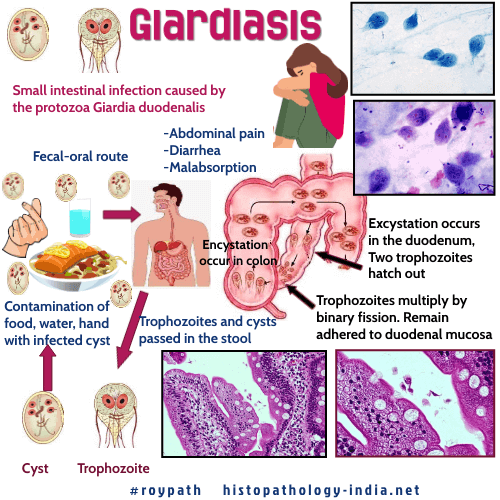
Giardiasis is a small
intestinal infection caused by the protozoa Giardia duodenalis (also
referred to as Giardia lamblia and Giardia intestinalis).
Giardia duodenalis
is a pear or sickle shaped, binucleate protozoa.
Giardia exists as infectious cysts in contaminated food and water
which spread by fecal-oral route and as trophozoites which multiply in
the intestinal lumen and cause disease.
Clinical
presentation:
Usually
asymptomatic. May present with epigastric or right upper quadrant pain
and persistent steatorrhoea. Increase in severity of the case correlate
with factors such as achlorhydria and low secretary IgA level (agammaglobulinemic
patients)
How does
it differ from Entamoeba histolytica?
Giardia duodenalis
trophozoites are pear-shaped,have two nuclei and are flagellated.
Reside in the duodenum rather than colon.
Adhere to the intestinal epithelial cell rather than invading the
epithelium, thus causing diarrhoea rather than dysentery.
Mode of
action:
The
trophozoites adhere to the sugars on the intestinal epithelial cells via
parasite lectin which is activated when cleaved by proteases. Tight
contact is made between parasite and intestinal epithelial cell via
sucker-like disc.
Giardia block nutrient absorption by covering the surface of the
epithelial cells or by damaging the microvilli.
Histologic
features:
One or two duodenal punch biopsy specimens are adequate for diagnosis
(site of colonization of organism may vary ).
Diagnostic feature: Identification of sickle shaped organism attached
to the surface or
free within the mucus layer.
Biopsy features range from normal to abnormal appearance of the
intestinal mucosa.
Mucosal changes are minimal in most cases.
In some cases here may be clubbing of villus and decreased villus-crypt
ratio.
Crypt hyperplasia and focal epithelial damage may be noted.
An increased mononuclear infiltrate may be present in the lamina propria.
There may be increased intraepithelial lymphocytes.
The brush border of the absorptive cells may be irregular.
Sometimes villi may be absent and resemble atrophic stage of
gluten-induced enteropathy.
In case of immunodeficient patients, the histopathologist should look
for plasma cells in the lamina propria.
Nodular follicular
hypertrophy of the mucosal lymphoid tissue is associated with common
variable immunodeficiency.
Crypt cell loss and
apoptosis may be noted in HIV
(human immunodeficiency
virus)
positive cases.
|




